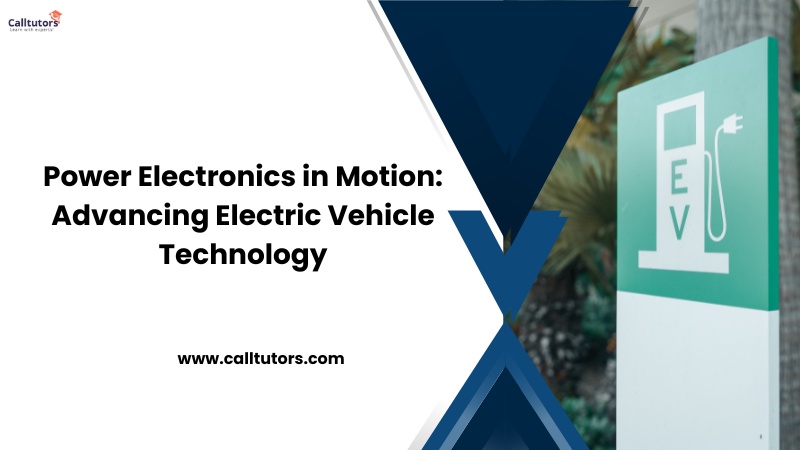Introduction
Power electronics and electric vehicle (EV) technologies are defining a dynamic synergy that is undergoing a significant change in the automobile sector. This investigation delves into the complex world of electrons and mobility, revealing how power electronics have been instrumental in driving the development of electric cars. The interaction of power electronics is becoming more than simply a technical breakthrough; it is reshaping transportation in fundamental ways as electric propulsion replaces internal combustion engines.
Power electronics are already permeating the vehicle scene, blending in with the mechanical buzz of engines to create a symphony of energy storage, conversion, and propulsion. More than just a technical integration, this mutually beneficial partnership is a story that will determine the future of transportation. According to this story, power electronics plays the role of a maestro conductor, orchestrating the flow of electrons to make electric cars more than just an alternative to gas-powered vehicles; they usher in a new age of environmentally friendly and technologically advanced transportation.
Note: If you are a student and struggling with your Electrical Engineering Homework , then you can get the best Electrical Engineering Homework Help from our experts.
What is power electronics?
The study and use of electronic devices and systems for controlling and converting electric power is the focus of power electronics, a subfield of electrical engineering. It entails controlling the electric power's voltage, current, and frequency with efficiency and precision by manipulating electrical power using solid-state electronics.
Key aspects of power electronics
Power Converters
Power converters are fundamental components in power electronics. They are circuits or devices that convert electric power from one form to another. Common types of power converters include rectifiers, inverters, and converters that change the voltage level or frequency of electrical power.
Semiconductor Devices
Power electronic systems heavily rely on semiconductor devices, such as diodes, transistors (including power MOSFETs and IGBTs), and thyristors (SCRs). These devices are used to switch and control the flow of electrical power in various applications.
Switching Power Supplies
Power electronics is integral to the design of switching power supplies. These supplies efficiently convert electrical power from one voltage level to another, typically for purposes like voltage regulation or AC-to-DC
Conversion.
Motor Drives
Power electronics plays a crucial role in motor drives, where it is used to control the speed and torque of electric motors. Variable Frequency Drives (VFDs) are a common application in which power electronics is employed to regulate the speed of electric motors.
Renewable Energy Systems
Among other things, power electronics are crucial to solar and wind power systems. In order for renewable energy sources like solar panels and wind turbines to feed into the grid, inverters transform the DC current they generate into the AC current that appliances and electronics need.
Electric Vehicles
The propulsion systems of electric vehicles (EVs) heavily rely on power electronics. It is used to control the charging and discharging of batteries, regulate the power flow between the battery and the electric motor, and achieve efficient energy conversion.
Voltage Regulation and Reactive Power Control
Power electronics is employed in systems for voltage regulation and reactive power control in electrical grids. FACTS (Flexible AC Transmission Systems) devices use power electronics to enhance the controllability and stability of AC power systems.
Importance Of Power Electronic In Motion
Power electronics play an essential and complex role in mobility, especially in relation to EVs and other forms of electrical transportation. Here are some details that emphasize its importance:
Efficient Energy Conversion
Power electronics facilitate the efficient conversion of electrical energy within the propulsion systems of electric vehicles. They control the flow of power between the vehicle's battery and the electric motor, ensuring optimal energy conversion and minimizing losses during acceleration, deceleration, and cruising.
Motor Drive Control
In electric vehicles, power electronics are crucial for precise control of the electric motor drives. This allows for fine-tuning of parameters such as torque, speed, and regenerative braking, resulting in smoother acceleration, enhanced performance, and improved overall efficiency.
Battery Management
Power electronics play a key role in managing the charging and discharging of the vehicle's battery. Their job is to control the amount of power going into and out of the battery, making sure everything runs smoothly and safely. In order to keep each cell in the battery pack in check and balanced, modern BMSs employ power electronics.
Regenerative Braking
Power electronics enable regenerative braking, a feature in many electric vehicles. During braking or deceleration, the electric motor operates in reverse, acting as a generator. Power electronics control the energy generated during this process, converting it back into electricity and feeding it back to the battery for storage.
Fast Charging Capability
The development of fast-charging technologies for electric vehicles heavily relies on power electronics. High-power chargers, equipped with advanced power electronics, allow for rapid charging, reducing the time required to charge an electric vehicle and improving the convenience for users.
Enhanced Control Strategies
Power electronics enable sophisticated control strategies in electric vehicles. This includes torque vectoring, where power can be selectively applied to individual wheels, improving vehicle stability, handling, and overall performance.
Integration with Smart Grids
During times of high demand, electric cars may not only consume energy but also send extra power back to the grid thanks to the management of bidirectional energy flow.
Reduction of Environmental Impact
Power electronics help reduce emissions of greenhouse gases and reliance on fossil fuels by facilitating the broad deployment of electric cars. Achieving sustainable and ecologically friendly mobility may be achieved via the electrification of transportation.


No comments yet